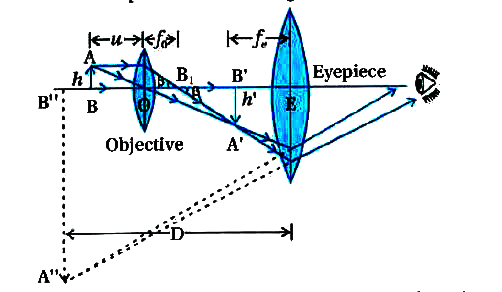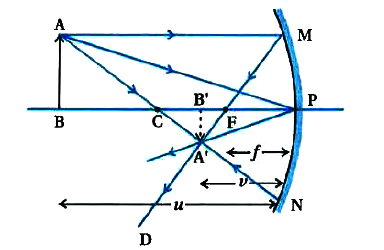What is compound microscope ? Explain by figure of its construction. Solution in Gujrati
A simple microscope has a limited maximum magnification (≤9) for realistic focal lengths. For much larger magnification, one uses two lenses one compounding the effect of the other. This is known as a compound microscope.
A schematic diagram of a compound microscope is shown in figure.

The lens nearest the object called the objective forms a real inverted, magnified image of the object.
This serves as the object for the second lens, the eyepiece, which functions essentially like a simple microscope or magnifier, produces the final image which is enlarged and virtual.
The first inverted image is thus near (at or within the focal plane of the eyepiece at a distance appropriate for final image formation at infinity, or a little closer for image formation at the near point. Clearly the final image is inverted with respect to the original object.
Topper's Solved these Questions
- RAY OPTICS AND OPTICAL INSTRUMENTSBOOK - KUMAR PRAKASHANCHAPTER - RAY OPTICS AND OPTICAL INSTRUMENTSEXERCISE - SECTION - A (TRY YOURSELF)
74 Videos
- RAY OPTICS AND OPTICAL INSTRUMENTSBOOK - KUMAR PRAKASHANCHAPTER - RAY OPTICS AND OPTICAL INSTRUMENTSEXERCISE - SECTION-B (NUMERICALS)(NUMERICAL FROM TEXTUAL ILLUSTRATIONS)
17 Videos
- MOVING CHARGES AND MAGNETISMBOOK - KUMAR PRAKASHANCHAPTER - MOVING CHARGES AND MAGNETISMEXERCISE - SECTION D (MCQs ASKED IN COMPETITIVE EXAMS)
34 Videos
- SAMPLE QUESTION PAPER BOOK - KUMAR PRAKASHANCHAPTER - SAMPLE QUESTION PAPER EXERCISE - PART-B SECTION-C
5 Videos
Similar Questions
Give range of wavelength of visible light.
View SolutionSuppose that the lower half of the concave mirror.s reflecting surface as shown in figure is covered with an opaque (non-reflective) material. What effect will this have on the image of an object placed in front of the mirror ?

View SolutionElectric charge Q having mass M moves on a circular path of radius R with velocity →v, perpendicular to uniform magnetic field B. When a particle completes one revolution, work done by the field is _______
View SolutionTwo charges –q and +q are located at points (0, 0, –a) and (0, 0, a), respectively.
(a) What is the electrostatic potential at the points (0, 0, z) and (x, y, 0) ?
(b) Obtain the dependence of potential on the distance r of a point from the origin when r/a>>1 .
(c) How much work is done in moving a small test charge from the point (5,0,0) to (–7,0,0) along the x-axis? Does the answer change if the path of the test charge between the same points is not along the x-axis?
View SolutionDescribe the construction and working of compound microscope.
View SolutionWith a neat labelled diagram, explain the construction and working of a compound microscope.
View SolutionExplain the construction and working of a 'Compound Microscope'.
View SolutionExplain the construction of Simple Microscope.
View SolutionExplain the construction and working of a 'Compound Microscope'.
View SolutionExplain the construction of Simple Microscope.
View SolutionExplain about compound mircoscope and obtain the equation for magnification. Compound microscope:
View SolutionExplain the construction and working of a 'Compound Microscope'.
View SolutionExplain the construction and working of a 'Compound Microscope'.
View SolutionExplain the construction of simple microscope and derive its magnification power.
View Solution(a) (i) Explain the construction and working of a 'Compound Microscope' with a neat diagram.
(ii) State Snell's Law.
View Solution
